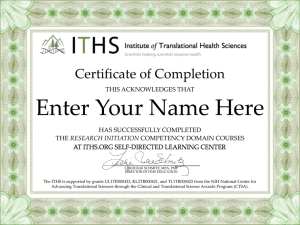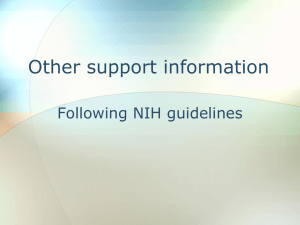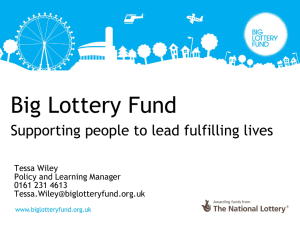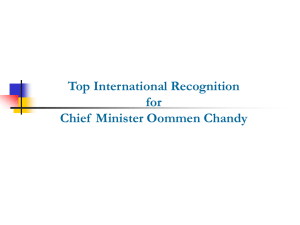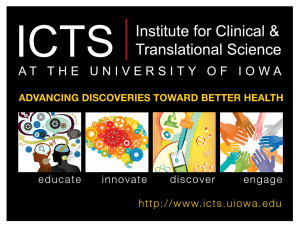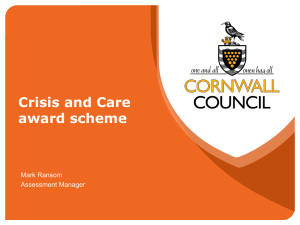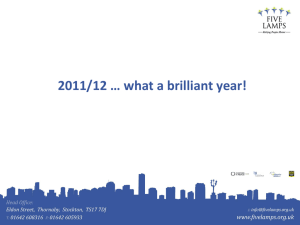(K23) Mentored Clinical Scientist Development Award
advertisement
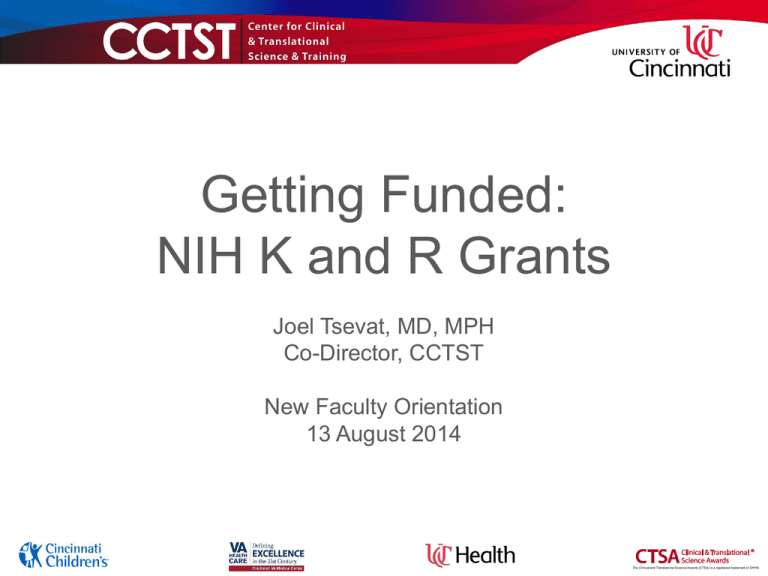
Getting Funded: NIH K and R Grants Joel Tsevat, MD, MPH Co-Director, CCTST New Faculty Orientation 13 August 2014 The Clinical and Translational Science Awards (CTSA) is a registered trademark of DHHS. Getting Started • K (Career Development Award) or R (Research Grant)? • Allow at least 6 months for an R01, 10-12 months for a K award • Figure out where to submit – Talk to your mentor(s) – Find a Funding Opportunity Announcement via NIH Guide for Grants and Contracts or Grants.gov – Look at specific Institute/Center websites – Call the program officer! • Read the instructions carefully: SF424 (R&R) • Look at previous successful applications, especially in the case of K awards • Register with eRA Commons The Clinical and Translational Science Awards (CTSA) is a registered trademark of DHHS. Career Development Awards Medical School Internship/Residency Specialty Mentored Clinical Scientist Development Award (K08) Independent Investigator Mentored Patient-Oriented Research CDA (K23) The Clinical and Translational Science Awards (CTSA) is a registered trademark of DHHS. Common Types of K Awards • • • • • • K01 Mentored Research Scientist Development Award K02 Independent Scientist Award K07 Academic Career Award: Development vs. Leadership K08 Mentored Clinical Scientist Development Award K22 Career Transition Award K23 Mentored Patient-Oriented Research Career Development Award • K24 Midcareer Investigator Award in Patient-Oriented Research • K25 Mentored Quantitative Research Development Award • K99/R00 Pathway to Independence Award Use the Career Award Wizard to find the right one for you The Clinical and Translational Science Awards (CTSA) is a registered trademark of DHHS. Common Features of NIH Career Development Awards • Salary, fringe benefits, research/development costs, 8% F&A – Salaries capped between $75,000 and legislated cap ($179,900) – Research/development costs generally $25,000 to $50,000 • • • • Duration: 3-5 years Entry-level awards require a mentor More senior awards are sometimes renewable Level of effort – Mentored awards require full-time effort (defined as at least 75% on research and the rest on other career development activities) – More senior awards either 25% to 50% or full-time • Eligibility – Doctoral degree (generally) – US citizen, non-citizen national, permanent resident – Previous NIH principal investigators may be ineligible The Clinical and Translational Science Awards (CTSA) is a registered trademark of DHHS. Anatomy of K Applications • • • • • • • • • • • • • Introduction to application (for resubmissions only) Candidate’s background Career goals and objectives Candidate’s plan for career development/training activities during award period Training in the responsible conduct of research Candidate’s plan to provide mentoring (K24 and K05 applications only) Plans and statements of mentor(s) Letters of support from collaborators, contributors, and consultants Description of institutional environment Institutional commitment to candidate’s research career development Specific aims Research strategy Etc. The Clinical and Translational Science Awards (CTSA) is a registered trademark of DHHS. Common Types of R Grants • R01 Research Project Grant – – – – Most common mechanism Generally 3-5 years No specific $ amount limit but need advance permission for > $500k/yr Mostly for more established investigators but special dispensation for new investigators • R03 Small Grant – 2 years – Generally ≤ $50k/yr direct costs • R21 Exploratory/Developmental Research Grant – 2 years – Total direct costs ≤ $275k The Clinical and Translational Science Awards (CTSA) is a registered trademark of DHHS. Anatomy of an R Application • Cover letter – Title, FOA number, requested study section, list of individuals/study sections who should not review, disciplines involved if multidisciplinary • • • • Title Project summary/abstract Project narrative Administrative sections – Budget, budget justification – Biosketches (with tailored personal statements), other support pages – Facilities and other resources The Clinical and Translational Science Awards (CTSA) is a registered trademark of DHHS. • • • Introduction to application (for resubmissions only) Specific aims Research strategy – Significance – Innovation – Approach • • • • References Human subjects, inclusion of women and minorities, inclusion of children Certain other sections Appendices and collaborative agreements – Appendices are generally limited to surveys, questionnaires, and other data collection instruments – Do not use them to circumvent the 12-page research plan limit – Don’t include manuscripts unless in press (max 3), letters of support, etc. • Planned enrollment table The Clinical and Translational Science Awards (CTSA) is a registered trademark of DHHS. Specific Aims • By far the most important piece of the application because it’s all that most reviewers will read • Official instructions – State concisely the goals of the proposed research and summarize the expected outcome(s), including the impact that the results of the proposed research will exert on the research field(s) involved. – List succinctly the specific objectives of the research proposed, e.g., to test a stated hypothesis, create a novel design, solve a specific problem, challenge an existing paradigm or clinical practice, address a critical barrier to progress in the field, or develop new technology. The Clinical and Translational Science Awards (CTSA) is a registered trademark of DHHS. Specific Aims – Tips • Should tell a story – – – – – – What is the public health or scientific problem (1-2 sentences)? What is known about your research topic (2-3 sentences)? What have you/your team done (don’t be modest!)? What gap(s) remain (1-2 sentences)? What questions will you answer (aims; hypotheses)? Who, when, where, how (summarize methods, study sites, sample size, etc.)? – Summarize the impact (1-2 sentences) • Career development awards should also weave in – Gaps in your knowledge base and why you need additional training – Mention of your mentorship team and environment – Why you are perfectly positioned to do this – remember, career development awards are about you! The Clinical and Translational Science Awards (CTSA) is a registered trademark of DHHS. Significance • Explain the importance of the problem or critical barrier to progress in the field that the proposed project addresses. • Explain how the proposed project will improve scientific knowledge, technical capability, and/or clinical practice in one or more broad fields. • Describe how the concepts, methods, technologies, treatments, services, or preventative interventions that drive this field will be changed if the proposed aims are achieved. The Clinical and Translational Science Awards (CTSA) is a registered trademark of DHHS. Innovation • Explain how the application challenges and seeks to shift current research or clinical practice paradigms. • Describe any novel theoretical concepts, approaches or methodologies, instrumentation or interventions to be developed or used, and any advantage over existing methodologies, instrumentation, or interventions. • Explain any refinements, improvements, or new applications of theoretical concepts, approaches or methodologies, instrumentation, or interventions. The Clinical and Translational Science Awards (CTSA) is a registered trademark of DHHS. Approach • • • • • • • • • • Overview Preliminary studies (results, feasibility) Study subjects Study procedures Measurements (outcomes, predictor variables, confounders) Statistical analysis Data management and quality control Resource sharing plans Timetable and org chart Limitations, potential problems, and alternative approaches The Clinical and Translational Science Awards (CTSA) is a registered trademark of DHHS. Page Limits Section Page Limit* Introduction to Resubmission Application 1 Specific Aims 1 Research Strategy 12 or 6 (R03, R21) Candidate’s Background, Career Goals and Objectives, and Career Development/Training Activities During Award Period and Research Strategy (K awards) 12 Plan for Instruction in the Responsible Conduct of Research (K awards) 1 Letters from mentors (K awards) 6 Letters from collaborators (K awards) 6 Biosketch (per investigator) 4 Appendix 10 PDF attachments *Double-check specific FOA instructions The Clinical and Translational Science Awards (CTSA) is a registered trademark of DHHS. Letters of Reference for Career Development Awards PROGRAM K01 K02 K05 K07 K08 K18 K22 K23 K24 K25 K26 K99/R00 DESCRIPTION Mentored Research Scientist Development Award Independent Scientist Award Senior Scientist Award Academic Career Award Mentored Clinical Scientist Development Award Career Enhancement Award Career Transition Award K23 Mentored Patient-Oriented Research Career Development Award Mid-Career Investigator Award in Patient Oriented Research Mentored Quantitative Research Career Development Award Midcareer Investigator Award in Mouse Pathobiology Research NIH Pathways to Independence (PI) Award MENTOR Yes No No * Yes Yes * Yes No Yes No Yes REFERENCE LETTERS (3-5) Yes No No * Yes Yes Yes Yes No Yes No Yes *Varies; check FOA Note: these letters are from people not directly involved in the project and are submitted through eRA Commons The Clinical and Translational Science Awards (CTSA) is a registered trademark of DHHS. Review Process • Submit grant to Center for Scientific Review • 2 levels of review – Special Review Group (SRG) – study section – Advisory Council • Assigned to Program Officer and SRG – Scientific Review Administrator assigns to reviewers – Reviewers write written reports and assign preliminary scores – Prior to SRG meeting, triage of applications scored in bottom half The Clinical and Translational Science Awards (CTSA) is a registered trademark of DHHS. Reviewers Scores Overall Impact or Criterion Strength High Medium Low Score Descriptor 1 Exceptional 2 Outstanding 3 Excellent 4 Very Good 5 Good 6 Satisfactory 7 Fair 8 Marginal 9 Poor The Clinical and Translational Science Awards (CTSA) is a registered trademark of DHHS. Review Criteria – Research Project Grants Criterion Score Overall impact 1-9* Significance 1-9 Investigators 1-9 Innovation 1-9 Approach 1-9 Environment 1-9 Human subject protection Acceptable vs. not acceptable Inclusion of women and minorities Acceptable vs. not acceptable Inclusion of children Acceptable vs. not acceptable *Not necessarily an average of the other 5 criteria The Clinical and Translational Science Awards (CTSA) is a registered trademark of DHHS. Review Criteria – Career Development Awards Criterion Score Candidate 1-9 Career development plan 1-9 Research plan 1-9 Mentors, collaborators 1-9 Environment and institutional commitment to candidate 1-9 Human subject protection Acceptable vs. not acceptable Inclusion of women and minorities Acceptable vs. not acceptable Inclusion of children Acceptable vs. not acceptable The Clinical and Translational Science Awards (CTSA) is a registered trademark of DHHS. Study Section Meeting • Assigned reviewers summarize critiques • Open discussion • Final scoring of overall impact/priority scores • Summary statement prepared • Program officer may or may not be present The Clinical and Translational Science Awards (CTSA) is a registered trademark of DHHS. Advisory Council • NIH program staff assembles applications/scores/percentiles • Staff provide grant funding plan to Council • Council reviews applications based upon IC goals and advises Director • IC Director makes final funding decision The Clinical and Translational Science Awards (CTSA) is a registered trademark of DHHS. A Few Notes on Style • • Application must be well written; corollary: sloppiness will kill it because it annoys the reviewers and casts doubt on you as a researcher Use basic font (Arial, Helvetica, Palatino Linotype, or Georgia 11) throughout – – – – – – • • • • Font for tables can be smaller but make sure it’s still legible Avoid underlining – underlining went out with the typewriter Use bold font for section headings and subheadings Use italics sparingly – a word here, a few words there (e.g., for counterintuitive statements); don’t combine with bold font Bullets are fine Indicate changes from previous version with vertical line in left margin Use English and avoid jargon Use active voice Use common abbreviations liberally but don’t use many uncommon abbreviations; add a table of abbreviations on p. 1 of text Career development awards – – – Include a table of activities (coursework, research, clinical) with respective percent efforts for each year Gantt charts are useful; specify by quarter or even by month 1st person vs. 3rd person The Clinical and Translational Science Awards (CTSA) is a registered trademark of DHHS. Before You Submit • Understand the grant resubmission policy – Old grant submission policy: 2 strikes (A0 and A1) and you’re out in the old ballgame – For NIH and AHRQ grants, effective April 2014, following an unsuccessful resubmission (A1) application, applicants may submit the same idea as a new (A0) application, but without the ability to respond formally to the previous reviews • • Get your colleagues, friends, and enemies to read it before it goes out, allowing ample time to make changes Proofread, proofread, proofread – Typos – Grammatical errors – References • Try to avoid last-second edits – If they are substantive changes, re-read entire draft to ensure internal consistency The Clinical and Translational Science Awards (CTSA) is a registered trademark of DHHS. CCTST Funding Opportunities The Clinical and Translational Science Awards (CTSA) is a registered trademark of DHHS. CCTST Funding Opportunities The Clinical and Translational Science Awards (CTSA) is a registered trademark of DHHS. The Clinical and Translational Science Awards (CTSA) is a registered trademark of DHHS. References • Hulley SB, Cummings SR, Browner WS, Grady DG, Newman TB. Designing Clinical Research (4th ed.). Philadelphia: Lippincott Williams & Wilkins; 2013. • NIAID website: http://www.niaid.nih.gov/researchfunding/newsletter/Pages/default.aspx • NIH website: http://grants.nih.gov/grants/writing_application.htm • SF424 (R&R) Application Guide for NIH and Other PHS Agencies (updated 25 July 2013) The Clinical and Translational Science Awards (CTSA) is a registered trademark of DHHS. Funding Your Research-NSF Michael Sokoloff, PhD Department of Physics University of Cincinnati 556-0533 The Clinical and Translational Science Awards (CTSA) is a registered trademark of DHHS. Divisions of the NSF • Biological Sciences • Computer Information, Science and Engineering • Education and Human Resources • Engineering • Environmental Research • Geosciences • Math and Physical Sciences • Polar Research • Social and Behavioral and Economic Sciences The Clinical and Translational Science Awards (CTSA) is a registered trademark of DHHS. Additional Aspects • Cyberinfrastructure • Cross-cutting (e.g. Research Experiences for Undergraduates) • Integrative Activities • International Activities, Collaboration • Focus: Broadening Participation/Diversity The Clinical and Translational Science Awards (CTSA) is a registered trademark of DHHS. Special Considerations • Two review criteria for all proposals: Intellectual Merit and Broader Impacts • Data Management Plan • Postdoc Mentoring Plan • Certification Regarding Responsible Conduct of Research (RCR) The Clinical and Translational Science Awards (CTSA) is a registered trademark of DHHS. Limitations • Research with disease-related goals, including work on the etiology, diagnosis or treatment of physical or mental disease, abnormality, or malfunction in human beings or animals, is normally not supported. Animal models of such conditions or the development or testing of drugs or other procedures for their treatment also are not eligible for support. • Bioengineering that applies engineering knowledge to problems in biology and medicine while advancing engineering knowledge is eligible for support The Clinical and Translational Science Awards (CTSA) is a registered trademark of DHHS. NSF CAREER Grants CAREER: The Faculty Early Career Development (CAREER) Program is a Foundation-wide activity that offers the National Science Foundation's most prestigious awards in support of junior faculty who exemplify the role of teacherscholars through outstanding research, excellent education and the integration of education and research within the context of the mission of their organizations. Such activities should build a firm foundation for a lifetime of leadership in integrating education and research. NSF encourages submission of CAREER proposals from junior faculty members at all CAREER-eligible organizations and especially encourages women, members of underrepresented minority groups, and persons with disabilities to apply. The Clinical and Translational Science Awards (CTSA) is a registered trademark of DHHS. DOE CAREER Grants The Office of Science of the Department of Energy announces the fiscal year 2015 Early Career Research Program. The funding opportunity for researchers in universities and DOE national laboratories was announced July 30, 2014. The Early Career Research Program, now in its sixth year, supports the development of individual research programs of outstanding scientists early in their careers and stimulates research careers in the disciplines supported by the DOE Office of Science. Opportunities exist in the following program areas: Advanced Scientific Computing Research (ASCR); Biological and Environmental Research (BER); Basic Energy Sciences (BES), Fusion Energy Sciences (FES); High Energy Physics (HEP), and Nuclear Physics (NP). Mandatory pre-applications/pre-proposals are due at 5 PM Eastern Time on September 11, 2014. The Clinical and Translational Science Awards (CTSA) is a registered trademark of DHHS. Preparing Proposals • Talk to the Program Officers. They want to receive the strongest applications possible, so they will offer good guidance. • Look at the abstracts of funded research online. See what level of funding is typically provided. • Attend the proposal preparation workshop offered by the office of the VP for Research. • Pretend that your application is an essay contest. Your science must be excellent, but you are competing with other excellent scientists. The quality of the prose, the organization of the material, and the story you tell are critical to your funding success. • Ask for help. And give your mentors-to-be enough time. The Clinical and Translational Science Awards (CTSA) is a registered trademark of DHHS. Funding Agencies other than NIH and NSF The Clinical and Translational Science Awards (CTSA) is a registered trademark of DHHS. Sources of Support 1972 - 2012 • NSF 19 % • NIH 12 • DOE 27 • DOD 11 • EPA 5 • Industrial • Ohio 25 • Misc. 0.1 0.9 The Clinical and Translational Science Awards (CTSA) is a registered trademark of DHHS. Ohio • Edison Sensor Technology Center • Ohio Board of Regents • Instrumentation Grants • Ohio Technology Action Fund • Commercialization with industrial partner • Ohio Third Frontier • Wright Centers of Innovation • Institute for Development & Commercialization • of Advanced Sensor Concepts The Clinical and Translational Science Awards (CTSA) is a registered trademark of DHHS. UC Foundation Thomas Seddon Director, Corporation & Foundation Relations Susan Dunlap Associate Director - Corporation & Foundation Relations Ph: 513-556-6361 susan.dunlap@uc.edu The Clinical and Translational Science Awards (CTSA) is a registered trademark of DHHS. What is UC Foundation… • Separate 501 C 3 tax exempt organization whose sole mission is increasing private (non- governmental) support for University of Cincinnati programs, research, scholarships, equipment, etc. • College Fundraisers – Alumni – Faculty Staff Campaign – Grateful Patient – General Community • Central Units – Support College & University Wide Fundraising – Annual Support - Mailings, Telefund, and Social Media – Planned Giving – Corporate Foundation & Relations (CFR) The Clinical and Translational Science Awards (CTSA) is a registered trademark of DHHS. Partnering with CFR Concept Request for Prospect Support Research Feedback LOI/Proposal Submission OR Reporting *Also compile and e-mail weekly RFP list The Clinical and Translational Science Awards (CTSA) is a registered trademark of DHHS. Helpful Tips • Use CFR as a resource • Be a Good Partner – Answer emails/phone calls – Meet deadlines – Be partner in monitoring/reviewing foundation web-sites and publications • Submit CV to faculty expertise database • Share your network of colleagues, alumni & friends The Clinical and Translational Science Awards (CTSA) is a registered trademark of DHHS. UC Corporate Partners Program • The University of Cincinnati has enjoyed a long history of corporate support and has developed long-term relationships with many corporations. • Companies want to engage universities on an enterprise, not just a philanthropic basis, focusing their interactions that provide strategic benefits and ROI. The Clinical and Translational Science Awards (CTSA) is a registered trademark of DHHS. University of Cincinnati Corporate Partners Opportunities There are many opportunities on the UC campus for corporation/business involvement. We need to maximize the touch points to fully develop each partnership. The Clinical and Translational Science Awards (CTSA) is a registered trademark of DHHS. Corporate Partners Opportunities Recruit and Develop Talent Training and Workforce Development Entertain your Employees or Customers Access UC’s Research Expertise Transfer Technology Partner with UC Forward IT Solutions Center The Clinical and Translational Science Awards (CTSA) is a registered trademark of DHHS. Corporate Partners Opportunities Entrepreneurship & Community Development Clinic Sponsor Events and Programs UC Corporate Alumni Network Matching Gift Programs Provide Goods and Services to UC Invest in the Future through Philanthropy Customized Options The Clinical and Translational Science Awards (CTSA) is a registered trademark of DHHS.
